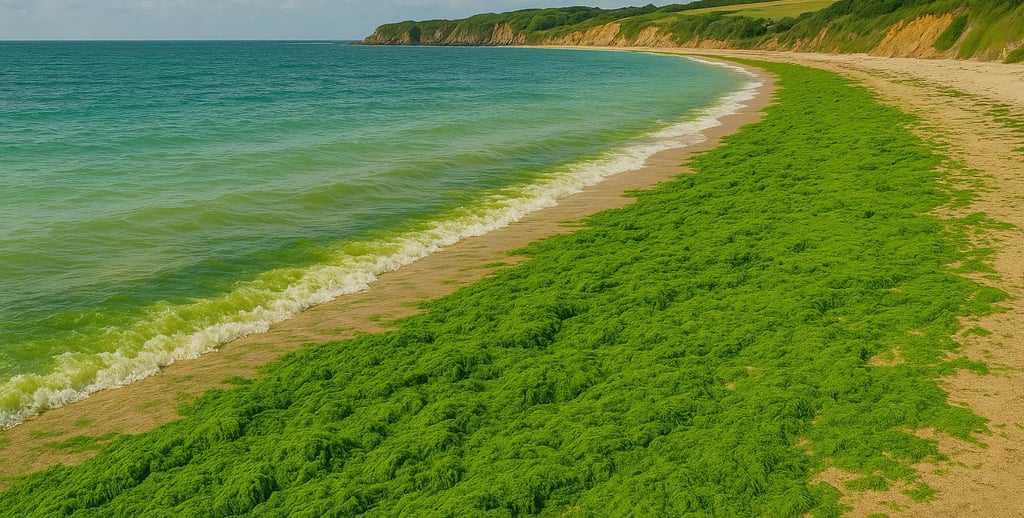Green algae : mandatory nitrate reduction
EUROPE
Thomas dos Remedios
5/10/20254 min read


The decision of the Rennes Administrative Court on 13 March marks a major turning point in the fight against the green tides that have been polluting Brittany's coastline for over fifty years. By ordering the prefecture of the Brittany region to take concrete measures to effectively reduce water pollution by nitrates from agricultural sources, the court recognised the inadequacy of the public policies implemented to date.
The decision was welcomed by the association Eau et Rivières de Bretagne, which had brought the case to court in October 2022 after the authorities had failed to act. Its secretary general, Nicolas Forray, described the ruling as a ‘victory’ and a ‘first step’ towards a tangible improvement. However, he stresses that this progress will only be truly significant if concrete measures are taken within the allotted timeframe.
A MAJOR HEALTH ISSUE
Green algae, which have been proliferating on the Brittany coast since the 1970s, are the direct result of nitrate pollution, mainly from intensive farming. According to a report by the Cour des Comptes and the chambre régionale des comptes published in 2021, the policy to combat these green tides is deemed ineffective, in particular due to poorly defined objectives and a lack of coherence with agricultural and environmental policies.
The court pointed out that, despite the efforts made, the average concentration of nitrates in Brittany's waterways is falling more slowly than before, and that the eight bays covered by the plan to combat green algae still exceed the regulatory threshold of 18 mg/L. As well as being a visual and olfactory nuisance, this pollution poses a real health risk. The decomposition of green algae leads to the emission of hydrogen sulphide (H₂S), a toxic gas that can be fatal in high doses.
Recently, the Brest public prosecutor confirmed that the death of a wild boar on a Côtes-d'Armor beach in September 2024 was linked to this gas. Cases of illness, poisoning and even human death have been suspected in the past, notably that of a jogger in 2016 in the Bay of Saint-Brieuc, although the absence of a rapid autopsy has prevented any definitive conclusion.
RESIDENTS AND THEIR ELECTED REPRESENTATIVES POWERLESS
In Hillion, one of the towns most affected by this scourge, Mayor Annie Guennou expresses her dismay. In office since 2022, she has had to order the closure of several beaches due to dangerous levels of hydrogen sulphide. Deploring the lack of an effective response from the state, she says that the prefectoral services recommend that she keep the beaches closed all summer, which she considers insufficient and unacceptable. Her feelings of abandonment have even prompted her to consider resigning.
The residents, too, are torn between resignation and anger. Some, like the Buard couple, are fed up with the stench and the nuisance of green algae. Others, like Corentin Fleury, play down the seriousness of the situation, as they are used to living with these nuisances. However, health concerns persist, with many complaining of headaches, irritation and respiratory problems.
AN UPHILL LEGAL BATTLE
While the court's decision represents a step forward, it does not put an end to the legal battle. Eau et Rivières de Bretagne had also requested a penalty payment of one million euros per month for any delay in implementing the measures, a request that was rejected by the court. However, the association remains vigilant and promises to take the case to court again if the government does not comply with the ten-month deadline imposed on it.
The second action brought by the association sought recognition of the State's responsibility for the ecological damage caused by its inaction. The court partially upheld this claim by ordering the State to pay the association €5,000, while acknowledging that the failure to combat the green tides had indeed caused ecological damage.
Inspired by the ‘Affaire du Siècle’ case, this appeal is part of a wider strategy aimed at changing the legal framework for the State's environmental liability. For its part, the Prefecture of Brittany has stated that it has taken note of the decision and is examining what action to take, without ruling out the possibility of an appeal. This cautious reaction reflects a certain reluctance on the part of the authorities to make a firm commitment to overhauling agricultural policies, despite the fact that many experts and activists consider this to be essential.
AN AGRICULTURAL MODEL CALLED INTO QUESTION
One of the main issues raised by this dossier is the questioning of the Breton agri-food model. Responsible for more than half of France's pork production on just 5% of the national territory, Breton agriculture has been singled out for its environmental impact. Yves-Marie Le Lay and André Ollivro, two historic figures in the fight against green tides, are denouncing the omerta that reigns on the subject. They are calling for a parliamentary enquiry to establish responsibility and force the government to act.
Monique, a resident of Hillion, sums up the local dilemma: "We produce to export to China, and in return we inherit this ecological disaster. Is that really reasonable? It's a thought that echoes the criticisms levelled by the Court of Auditors and numerous scientists, who are calling for an in-depth reform of the agricultural sector.
Yet the economic weight of agriculture makes it difficult to question. Many local people work in the sector and are reluctant to blame an industry that provides a living for the region. The balance between the economy and the environment remains fragile, and the court ruling, while important, will not be enough on its own to resolve this systemic problem.
The decision by the Rennes Administrative Court therefore represents a symbolic victory and a significant step forward in the recognition of the State's responsibility for green tides. However, it does not put an end to the environmental and health crisis that has afflicted Brittany for several decades.
The real challenge lies in the effective application of the measures ordered and the implementation of a sustainable agricultural policy. Only time will tell whether this decision represents a simple judicial step or the beginning of a genuine transformation of the Breton agricultural and environmental model.
Thomas dos Remedios, pour SPECTIO
Les propos exprimés n’engagent que leurs auteurs et ne reflètent pas la position du Think Tank Spectio.
